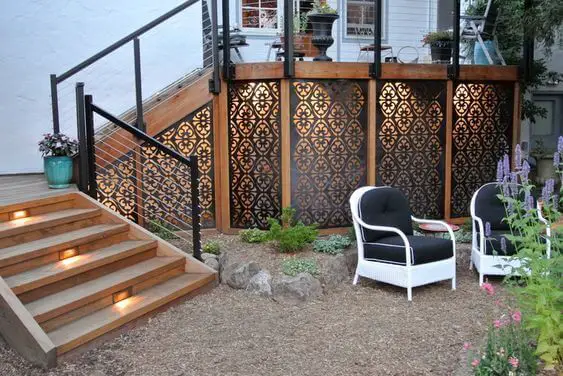There’s no denying that modern life can get fairly hectic at the worst of times. That’s why it’s so important to have a home space that you can feel comfortable in and look forward to returning to at the close of every day.
But a homey haven shouldn’t just include all the practical and functional creature comforts that you require to get by. Your home should really also be designed to act as a reflection of yourself and all the little things that bring you joy in life. Every little detail from the style of your bathroom tapware to the rugs and hallway runners that keep your toes comfy, should ideally be aligned with styles or aesthetics that resonate with you.
Of course, designing your own personal sanctuary is easier said than done. But it can be done! This little guide will feature a raft of inexpensive and simple ways that you can transform your home space into a sanctuary that replenishes your energy and fills you with a sense of belonging at the end of every day. Read on to start mapping out your own home transformation goals.
Contents
Step One: Declutter and Organise
One of the first steps to creating a peaceful and calming living space is to declutter and organise. It goes without saying that walking into a home that is full of mess and clutter won’t be likely to alleviate any stress at the end of the day.
Here are some quick and easy ways that you can declutter your home.
Simplify Your Space
That means it’s time for a cull. Get rid of anything that is junk, no longer practical or simply no longer brings you joy. This could include old clothes, outdated decor, or even any unused kitchen gadgets. Be sure to get right to the back of your kitchen and bathroom cabinets to do a thorough cleanout.
Less Mess Means Less Stress
Once you’ve decluttered, it’s time to organise. Invest in some storage solutions that work for your space, such as bookcases and standing shelves, baskets, shelving, or drawer dividers. With the right storage in place, identify where everything should be stored so it can be easily accessed when required. This will ensure that your home is not only neat and de-cluttered, but you will have more control and ultimately feel less overwhelmed.
Step Two: Create a Cosy Atmosphere
A comfortable home is a happy home, and creating a cosy environment is essential for promoting relaxation and tranquillity. Cultivating this atmosphere can be accomplished through a variety of methods, including incorporating soft lighting, comfortable seating, and warm textiles throughout your space.
Go For Soft & Cushy Items
Want to make your home feel extra comfy? Consider investing in a few pieces of plush furniture, such as a luxurious armchair or a cosy sectional sofa. Enhance your seating areas with soft, plush throw blankets and pillows that invite you and your wider household to snuggle up and unwind. Choose curtains or window treatments that let in natural light while still providing privacy, adding an element of warmth and serenity to your home.
Consider Sights & Sounds
In addition to soft furnishings, think about incorporating other sensory elements of cosiness into your home. This could include scented candles, which create a soothing ambiance and emit gentle fragrances that help you unwind. Warm wood accents can also contribute to a cosy environment by adding a touch of rustic charm and natural beauty.
And if you have the space and budget for some renovations, why not consider installing a cosy fireplace? This welcome addition to your home not only provides physical warmth, but can also act as a visual focal point. Imagine gathering around creates a soothing, crackling source of ambient light and sound at the end of a long winter’s day. And if the idea of installing a whole fireplace with a chimney doesn’t sound ideal to you, then simply opt for an electric fireplace.
Step Three: Bring Nature Indoors
Adding some indoor flowers and plants to your living space can make a real difference. Indoor plants and flowers have been shown to improve air quality, reduce stress, and enhance mood. They can also increase productivity, creativity, and concentration.
So how do you add plants and other natural elements into your home?
Add Low Maintenance Plants
If you’re new to caring for houseplants, you’ll be glad to hear that there are plenty of green little guys out there that are just as hard to kill as they are easy to love. Choose plants that suit your space and level of experience, like low-maintenance succulents or lush ferns, for instance. Place them in stylish planters and scatter them around your home to bring in a bit of nature.
Incorporate Natural Materials
If you don’t have a green thumb or live in a smaller home that cannot accommodate house plants, there are plenty of other ways to bring nature indoors. You may consider adding natural materials, like wood or stone to your home decor and design scheme. Or you could bring in a small water feature, like a tabletop fountain or perhaps even a fish tank. These natural elements can create a calming and peaceful environment in your home.
Step Four: Create a Relaxing Colour Scheme
Colour psychology is the study of how different colours can influence our emotions and overall mood. Colours can evoke various feelings, ranging from excitement to tranquillity, depending on the hue, saturation, and context in which they are used. So if you’re aiming for a relaxing and serene ambiance, choosing a gentle and comforting colour palette is a smart move. Shades of blue, green, and grey are fantastic options to explore here.
Use Cool Tones
Blue is a popular colour choice for creating a serene ambiance. And believe it or not, but the colour blue also comes with its fair share of health benefits, including lowering your blood pressure, slowing your heart rate, and generally reducing anxiety.
Green is another colour that has a calming effect on the mind and body. It is often linked to nature and can inspire feelings of peace and serenity. Lighter shades of green, such as mint or sage, can be especially soothing.
Grey is another versatile colour that can evoke a sense of calm and sophistication. This tone is also a perfect, muted option for places like bedrooms and home offices as it creates a quiet and relaxing environment. If you want to keep your home design as adaptable as possible, a muted colour like grey is also a superb bet.
Set The Mood
When choosing colours for your relaxing colour scheme, it’s important to think about the overall mood you want to create. Whether you choose blue, green, grey, or another colour across either the warm or cool colour spectrum, make sure to go for soft and muted shades to create a serene and calming atmosphere that enables you to switch off and truly relax.
Step Five: Personalise Your Sanctuary
And that finally brings us to the importance of personalisation. Truth be told, this element of your home transformation has actually been present throughout all of the prior steps outlined above. That’s because it is the personal touch that turns your house into a home. By incorporating items that hold sentimental value, you can create an environment that truly feels like a haven for relaxation and comfort.
Here are just a few ways you can personalise your serene sanctuary.
Display Family Photos and Artwork
Adorn your space with meaningful memories by displaying family photos or personal artwork. Choose frames that complement your chosen colour scheme and style, seamlessly integrating these cherished mementos into your decor. Surrounding yourself with visual reminders of your loved ones and accomplishments can foster a sense of warmth and happiness.
Curate Sentimental Objects and Keepsakes
Incorporate items with emotional significance into your sanctuary, like collections of souvenirs from travels, favourite novels, or handcrafted pottery. By surrounding yourself with items that have a special meaning, you’ll create an environment that feels uniquely yours.
Connect Your Space to Your Interests
Consider how to integrate your hobbies and passions into your sanctuary. Create a cosy reading nook, incorporate musical instruments into your decor, or display your favourite sports memorabilia. Weaving your interests into the design will make your personal sanctuary feel even more welcoming and tailored to your needs.
When it comes to creating a sanctuary, it’s important to identify what makes you feel relaxed and content. This can be different for everyone, so take the time to consider what elements of your home decor bring you joy and calm. Maybe it’s soft lighting, soothing colours, or comfortable furniture.
Or maybe it’s family photos, artwork, or sentimental objects. Whatever your fancy, adding these personal touches can help make your home feel more welcoming and relaxing, both for yourself and all your friends and loved ones.
And remember: while this guide offers practical solutions, the true key to creating a personal sanctuary is to think about elements that you’d like to add to your home. Have a brainstorming session and write down colours, styles, objects and decor items that make you feel happy (or spark joy!). By incorporating your own personality into your home design you can effectively create a space that is a true sanctuary.



